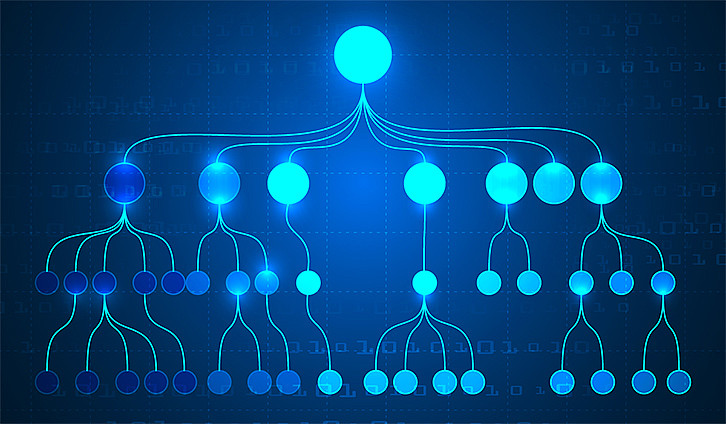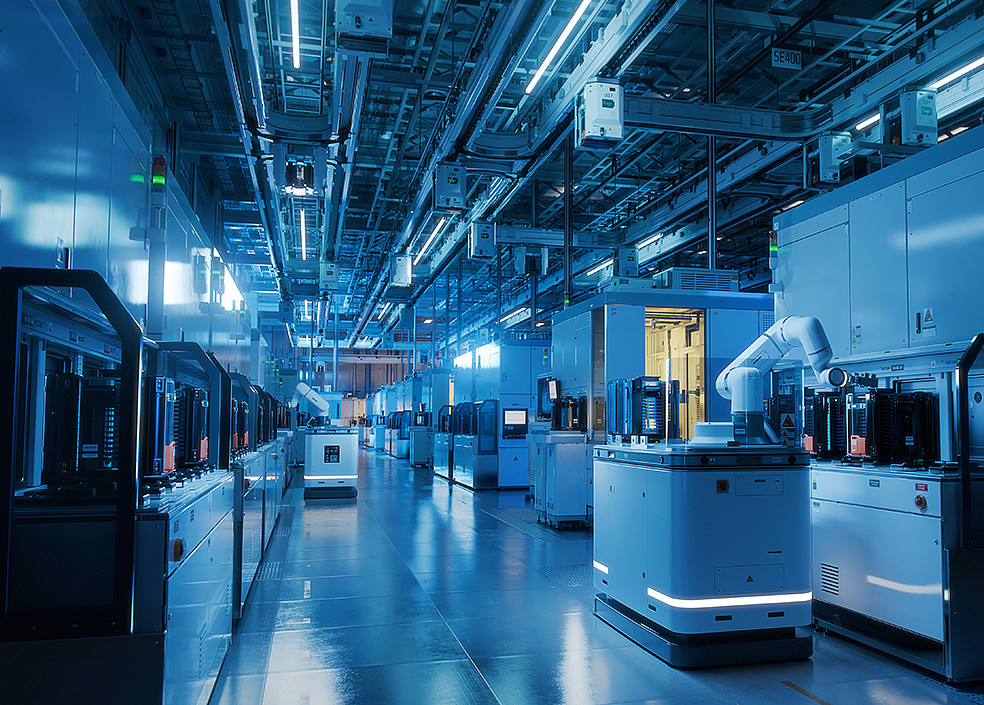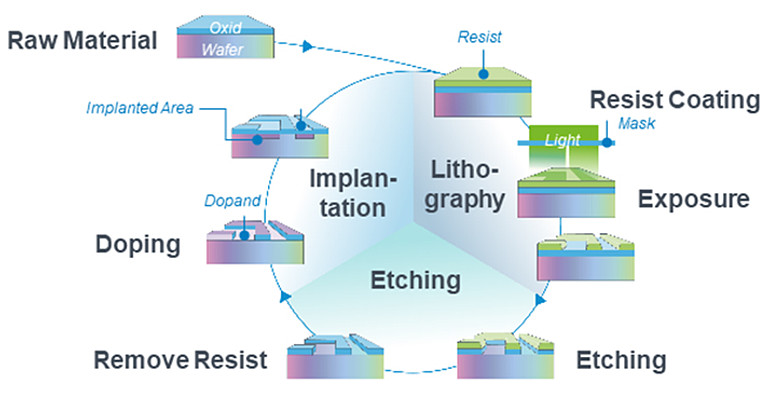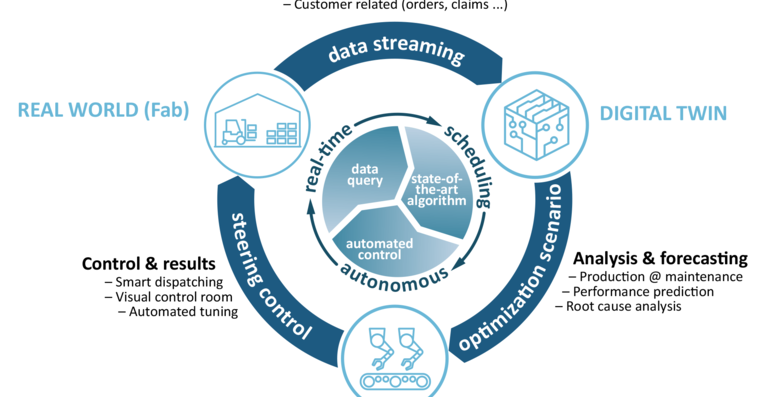Published on January 09, 2024
Mobilizing semiconductor factories with AI
Up to a few centimetres in size and yet so significant: microchips made of semiconductor materials, or semiconductor chips for short. They are the core of electrified products and digital devices, such as electric cars or smartphones. Depending on their function, electronic components and devices can contain several hundred to thousands of chips. Researchers from the Institute of Materials Handling and Logistics (IFL) at KIT work on the AISSI (Autonomous Integrated Scheduling for Semiconductor Industry) project to make the production of semiconductor chips more competitive and efficient with the help of machine learning. The aim is to enable manufacturers to better meet the high demand for chips in the face of a shortage of semiconductors. The AISSI consortium, led by Robert Bosch GmbH, also includes industry experts from Bosch Sensortec GmbH and Nexperia Germany GmbH as well as simulation and virtualization specialists SYSTEMA Systementwicklung Dipl.-Inf. Manfred Austen GmbH and D-SIMLAB Technologies GmbH.
The causalities of the chip shortage
A year ago, the bottleneck escalated into a huge chip crisis: chips were an extremely scarce commodity and manufacturing companies were slowed down by long waiting times. The cause of the ongoing shortage is the sum of several events in world affairs. For example, geopolitical tensions that lead to a supply shortage of the necessary raw materials. Semiconductor materials, such as the silicon typically used in chips, are still in short supply. At the same time, the corona pandemic did not remain without consequences for the chip industry in the years 2019 to 2022. Christoph Jacobi from IFL, who is responsible for AISSI at KIT, explains: "While some markets collapsed completely during the exceptional state, demand in other areas rose abruptly – especially in communication and consumer electronics. This resulted in adjustments to supply and manufacturing processes and consequently a shift in economic focus. Although the situation in the electronics industry has improved somewhat, advancing digitalization and the ever-shorter product life cycles of many electronic products continue to drive up global demand for microchips." This is associated with fierce competition among manufacturing companies. Andrej Gisbrecht, a machine learning expert at Robert Bosch GmbH, explains: "AISSI aims to enhance the ability of European semiconductor manufacturers to plan, produce and respond to an unprecedented demand for microchips. We believe that our results will help strengthen our market position as a manufacturer and the European semiconductor industry worldwide."
One chip is not like another
Although microchips are similar in their function, their structure can be completely different. Logistics expert Jacobi points out: "Manufacturing companies are faced with the challenge that semiconductor production is incredibly complicated. Due to the multi-layer structure of the so-called wafer, a chip passes through the production line up to 30 times. There are various production areas and work steps, such as coating, etching, polishing and cutting, which are carried out repeatedly." As long as production is designed for mass production and runs without major changes, this is not yet a problem. Millions of chips roll off the production line in mostly Asian or American mega-factories. However, if the focus is on high-quality, customized chips in smaller quantities, production planning becomes a Herculean task for man and machine. This type of production is known in professional circles as 'high mix, low volume' (HMLV). "In the specific case of Bosch, this means around 600 different products and 600 different chip models that need to be juggled. And each chip has its own route through the factory," says Gisbrecht.

Schedule – master plan for production
The industry expert confirms: "HMLV production is a European specialty. We mainly produce highly specialized chips, which come at a price. Ultimately, production planning for this wide range of variants is always about being able to make a reliable promise for delivery to customers – especially in times of crisis. Planning and scheduling, taking into account factors such as machine availability, personnel capacity and material availability, is therefore essential." Scheduling is the process of arranging, controlling and optimizing work and workload in the factory. The detailed work plan ensures that production tasks are carried out in a coordinated manner in order to meet customer deadlines, minimize idle times, make optimum use of available resources or reduce production time and costs. Computer-aided planning tools, which are usually rule-based, provide initial technical assistance here. Jacobi gives a simple example: "What comes in first is produced first – first in, first out. But this approach alone is usually not logistically and economically viable." Short-term and longer-term planning requires many critical decisions about when individual tasks and processes should begin and end.

With AI to the solution tree
Jacobi explains the complexity of small-scale chip production: "The process is so complicated because the output of each production area is its own input at a later point in time. This means that the performance of the system is very much self-dependent. On top of this, there are a very large number of product variants: it is estimated that the number of ways in which the lots could be arranged on the machines is roughly as large as the number of atoms in the universe." In order to determine the ideal sequence and timing of processing, these countless solution options would theoretically need to be evaluated. Figuratively speaking, the options and the subsequent options result in a huge, multi-level solution tree. "All the branches that start from the root node correspond to the possible decisions we can make. And once a decision has been made here, we jump one level further down the tree, which again shows a number of possibilities," says Jacobi, describing the decision-making process. The AISSI project team uses artificial intelligence to tackle this branching tree structure. Based on deep reinforcement learning (DRL), the system is able to narrow down the search in the overall solution tree. Developer Jacobi explains: "In principle, we are trying to train a learning system that can predict where the solution tree can no longer be searched sensibly and efficiently. The aim is to limit both the width and depth of the tree in order to restrict the search to a decision between a few more expedient solutions."
Training with graphs
To make this possible at all, a new AI model was developed for the semiconductor production use case based on the 4-M principle: the man power, the equipment as a machine, the material as a moving lot in production and the method in the sense of the work steps. "We have been working on providing this enormous amount of available data to the AI model, which was previously considered abstract. And in such a way that it is understandable both for us as humans and for the AI. To do this, we represent the entire production system as a graphical model. The product variants themselves are another entity in the graph," says Gisbrecht, giving an insight into the data structure. AISSI is based on realistic data based on real data from Bosch and Nexperia production. The combination of the tree search and the artificial neural networks results in an entire decision-making chain right up to the very last decision in the production process. With the chosen process plan, the output of the entire factory should ultimately be as stable and maximum as possible. Stability then goes hand in hand with predictability.
Put a virtual trial to the test
What works well in the model must first be proven in practice. A virtual training room was therefore created with the help of partner SYSTEMA. Based on real data from Bosch and Nexperia production, it was possible to create a very realistic digital twin. "The digital twin depicts the behavior of the production system and directly shows the impact of decisions in the simulation. This allows us to observe whether the decisions made by the system are good or bad. In order to virtually simulate the production process, we carried out specific simulation studies with the software from D-SIMLAB. The AI is therefore still interacting with the digital twin. This is essential in order to further develop the model and make it fit for use in the real world," Jacobi points out. "We also need to build trust in the AI's calculations. To do this, we need the ability to explain the decisions made by the AI system. We are working on this and exchanging ideas in specialist circles, such as at a VDI workshop in which we took part. We are incorporating the valuable insights gained in this way into our project," Jacobi continues.
By the end of the project in 2024, the project partners want to build an operational prototype. Another milestone is the development of a scheduling agent – software that receives input on the situation in the production environment and returns a decision – so that the AI can also be used in a production environment. One important insight of the project participants can already be summarized: "Artificial intelligence alone is not magic, it only becomes a powerful tool with specific domain knowledge," explains computer scientist Gisbrecht on behalf of the team.




comments about this article
No comments